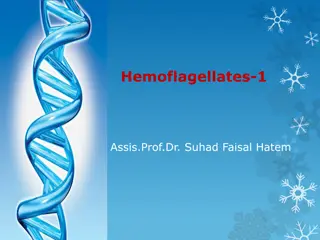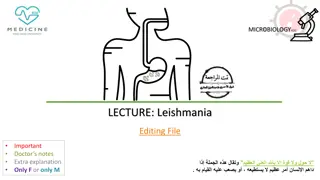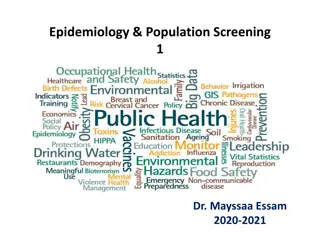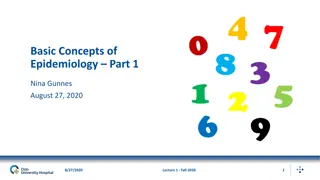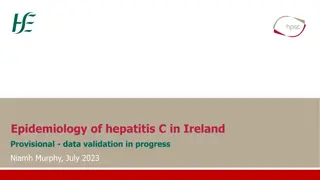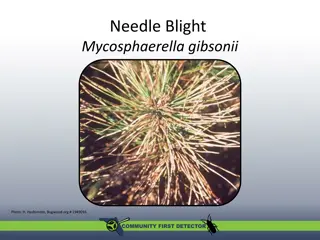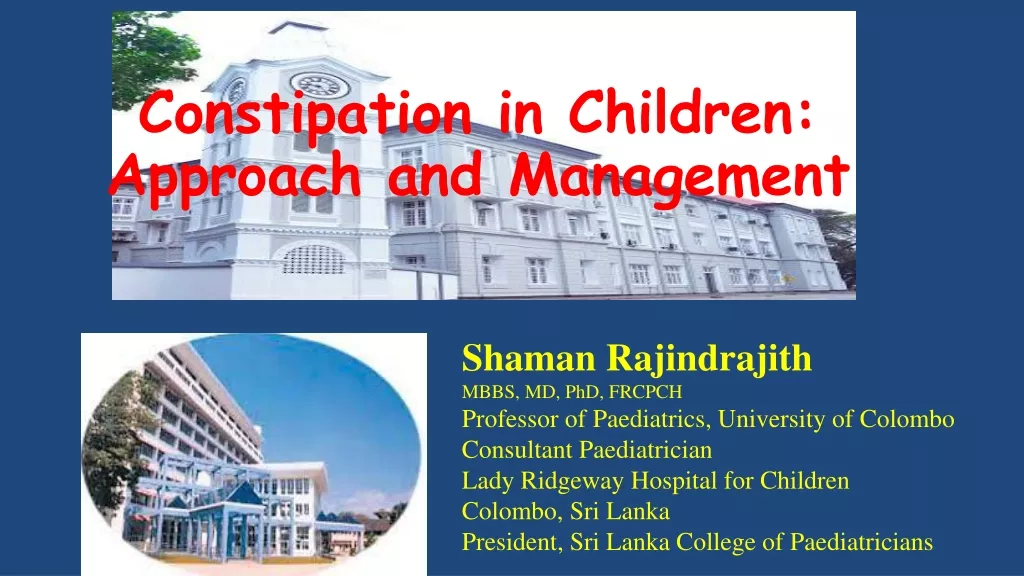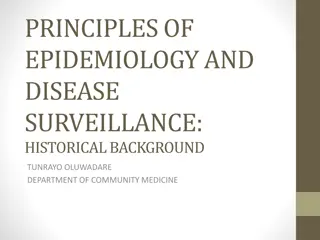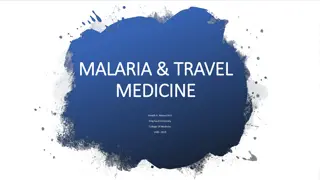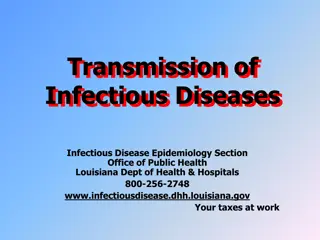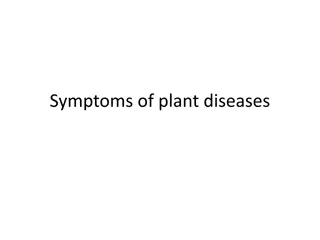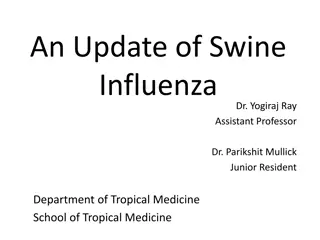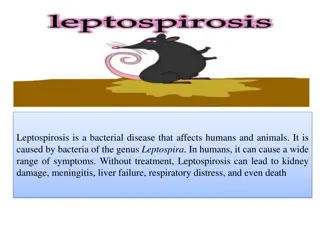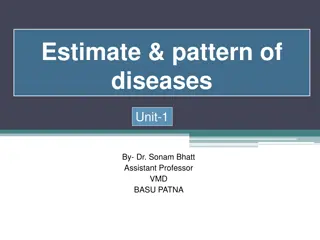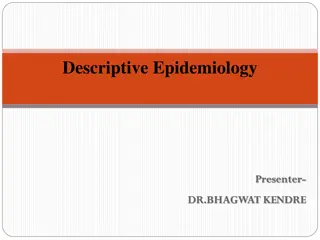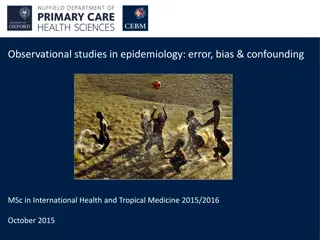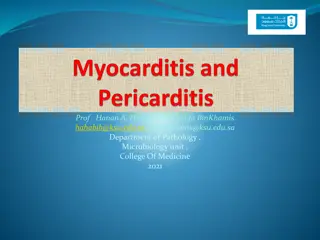Understanding Leishmaniasis: Transmission, Symptoms, and Epidemiology
Leishmaniasis, caused by obligate intracellular parasites transmitted through infected sandfly bites, has different forms including cutaneous, mucocutaneous, and visceral. The life cycle involves promastigote and amastigote stages. Epidemiologically, it is a zoonosis with natural reservoirs and can be transmitted to humans directly or mechanically. Cutaneous leishmaniasis is widespread in the Middle East and South America, while visceral leishmaniasis is prominent in Bangladesh, Brazil, India, Nepal, and Sudan.
Download Presentation

Please find below an Image/Link to download the presentation.
The content on the website is provided AS IS for your information and personal use only. It may not be sold, licensed, or shared on other websites without obtaining consent from the author. Download presentation by click this link. If you encounter any issues during the download, it is possible that the publisher has removed the file from their server.
E N D
Presentation Transcript
Leishmania Leishmania are obligate intracellular parasites that are transmitted from animal to human or human to human by bites from an infected female sandfly.
The promastigote stage (long, slender form with a free flagellum) is present in the saliva of infected sandflies. Human infection is initiated by the bite of an infected sandfly, which injects the promastigotes into the skin, where they lose their flagella, enter the amastigote stage, and invade reticuloendothelial cells. The change from promastigote to amastigote helps to avoid the host s immune response. Changes in the organism s surface molecules play an important role in macrophage attachment and evading the immune response, including manipulating the macrophage s signaling pathways. Reproduction occurs in the amastigote stage, and as cells rupture, destruction of specific tissues (e.g., cutaneous tissues, visceral organs such as liver and spleen) develops. The amastigote stage is diagnostic for leishmaniasis as well as serving as the infectious stage for sandflies. Ingested amastigotes transform in the sandfly into the promastigote stage, which multiplies by binary fission in the fly midgut. After development, this stage migrates to the fly proboscis, where new human infection can be introduced during feeding. The life cycles of Leishmania organisms are similar for cutaneous, mucocutaneous, and visceral leishmaniasis, except that infected reticuloendothelial cells can be found throughout the body in visceral leishmaniasis
Epidemiology Leishmaniasis is a zoonosis transmitted by adult female sandflies belonging to the genera Phlebotomus and Lutzomyia. The natural reservoirs include rodents, opossums, anteaters, sloths, cats, and dogs. In areas of the world where leishmaniasis is endemic, the infection may be transmitted by a human-vector-human cycle. The infection may also be transmitted by direct contact with an infected lesion or mechanically by stable flies or dog flies.
Mucocutaneous leishmaniasis most often occurs in Bolivia, Brazil, and Peru, whereas the cutaneous form is much more widespread throughout the Middle East (Afghanistan, Algeria, Iran, Iraq, Saudi Arabia, Syria) and in focal areas in South America (Brazil, Peru). Cutaneous leishmaniasis has been diagnosed among U.S. military personnel deployed in Afghanistan, Iraq, and Kuwait
Visceral leishmaniasis (kala-azar, Dumdum fever) occurs at a rate of approximately 500,000 new cases per year, 90% of which are localized to Bangladesh, Brazil, India, Nepal, and the Sudan. This infection may exist as an endemic, epidemic, or sporadic disease and is a zoonosis except in India, where kala-azar ( black fever in Hindi) is an anthroponosis (human-vector-human). Individuals with post kala- azar dermal leishmaniasis may be very important reservoirs for maintaining the infection in the population because of the high concentration of organisms in the skin.
Clinical Syndromes Depending on the species of Leishmania involved, infection can result Cutaneous Mucocutaneous visceral disease. With the spread of the HIV pandemic, there is increasing recognition of HIV-related visceral leishmaniasis caused by L. donovani in southern Asia and Africa and by L. infantum (L. chagasi) in South America. In these co-infected patients, leishmaniasis will manifest as an opportunistic infection, with parasites detected in atypical sites and a high associated mortality
cutaneous leishmaniasis A red papule, appears at the site of the fly s bite between 2 weeks and 2 months after initial exposure. The lesion becomes irritated and intensely pruritic and begins to enlarge and ulcerate Gradually the ulcer becomes hard and crusted and exudes a thin, serous material. At this stage, secondary bacterial infection may complicate the disease. The lesion may heal without treatment in a matter of months but usually leaves a disfiguring scar.
Mucocutaneous leishmaniasis The essential difference in clinical disease is the involvement and destruction of mucous membranes and related tissue structures. Untreated primary lesions may develop into the mucocutaneous form in up to 80% of cases. Spread to the nasal and oral mucosa may become apparent concomitant with the primary lesion or many years after the primary lesion has healed. The mucosal lesions do not heal spontaneously, and secondary bacterial infections are common, producing severe and disfiguring facial mutilation and occasionally death.
Visceral leishmaniasis The visceral form of leishmaniasis may present as fulminating rapidly fatal disease. The incubation period may be from several weeks to a year, with a gradual onset of fever, diarrhea, and anemia. Chills and sweating that may resemble malaria symptoms are common early in the infection. As organisms proliferate and invade the cells of the reticuloendothelial system, marked enlargement of the liver and spleen, weight loss, and emaciation occur. Kidney damage may also occur as the cells of the glomeruli are invaded. With persistence of the disease, deeply pigmented granulomatous areas of skin, referred to as post kala-azar dermal leishmaniasis, develop. In this condition, the macular or hypopigmented dermal lesions are associated with few parasites, whereas erythematous and nodular lesions are associated with abundant parasites.
Laboratory Diagnosis Demonstration of the amastigotes in properly stained smear. Specimens for the diagnosis of visceral leishmaniasis include splenic puncture, lymph node aspirates, liver biopsy, sternal aspirates, iliac crest bone marrow, and buffy coat preparations of venous blood. These specimens may be examined microscopically, cultured, and subjected to molecular detection methods. Specimens for the diagnosis of visceral leishmaniasis include splenic puncture, lymph node aspirates, liver biopsy. These specimens may be examined microscopically, cultured, and subjected to molecular detection methods. Serologic tests are available but not especially useful for the diagnosis of mucocutaneous or visceral leishmaniasis. Detection of urinary antigens has been used for the diagnosis of visceral leishmaniasis.
Treatment pentavalent antimonial compound sodium stibogluconate (Pentostam). Standard therapy for cutaneous leishmaniasis consists of injections of antimonial compounds directly into the lesion or parenterally. Recently, both fluconazole and miltefosine have been shown to be efficacious. Other agents include amphotericin B, pentamidine, and various formulations of paromomycin. Alternatives to chemotherapy in the treatment of cutaneous leishmaniasis include cryotherapy, heat, and surgical excision Stibogluconate remains the drug of choice for mucocutaneous leish hmaniasis, with amphotericin B as an alternative.


